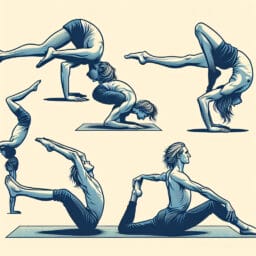
Unlocking Flexibility: A Comprehensive Guide to Pigeon Pose in Yoga
Table of Contents
- Introduction: The Importance of Flexibility in Yoga and Introduction to Pigeon Pose
- Understanding Pigeon Pose: Origin, Definition, and Role in Yoga
- The Physical and Mental Benefits of Pigeon Pose
- A Step-by-Step Guide to Pigeon Pose
- Common Mistakes and How to Avoid Them
- Modifications and Variations of Pigeon Pose
- Frequently Asked Questions
Introduction: The Importance of Flexibility in Yoga and Introduction to Pigeon Pose
Flexibility plays a crucial role in yoga, shaping our overall performance and enhancing the physical and mental benefits we derive from this ancient practice. Sculpting this vital aspect is the Pigeon Pose or Eka Pada Rajakapotasana as it’s known in traditional terms. This pose is not just an iconic part of various yoga routines but also a powerful hip opener that acts on commonly tight areas like hip flexors and piriformis muscles. As you transition from sun salutation sequences to resting your left leg straight on the yoga mat, your body experiences an increase in flexibility while simultaneously decreasing potential for injury. With its origins deeply rooted within studied yoga systems, mastering pigeon pose requires following a precise step-by-step guide to move correctly and avoid common mistakes such as misalignment of hips or undue strain on the lower back. But fret not, whether you’re a beginner seeking tips or an athlete looking for variations like king pigeon pose for deeper stretch, modifications are abundant to fit every style benefitting everyone from those facing chronic hip knee issues to those who spend long periods seated. Remember, while performing pigeon pose, focus on keeping your hips square to prevent back pain and use props like folded towel underneath your left hip if needed – it’s all about adjusting postures to suit individual anatomy while maintaining the essence of classic yoga poses.
Understanding Pigeon Pose: Origin, Definition, and Role in Yoga
Delving into the roots of Pigeon Pose, or Eka Pada Rajakapotasana as it is formally known in Sanskrit, reveals its profound influence on yoga practice. The term ‘Eka Pada Rajakapotasana’ breaks down into ‘eka’ meaning one, ‘pada’ representing foot or leg, ‘raja’ translates as king and ‘kapota’ signifies pigeon. This pose finds its origin in traditional yoga systems where it was renowned for being a potent hip opener and an integral part of various yoga sequences. Integrating this classic pigeon pose into a regular routine offers myriad benefits – from increasing flexibility to relieving back pain – by focusing primarily on the hip flexors and piriformis muscles which often tighten due to long periods of sitting or intense workouts like running and cycling. A helpful tip for beginners: approach the pose step-by-step, starting with downward facing dog then bring your left knee forward between your hands while extending the right leg straight behind you on a yoga mat. Ensure your hips are square and use modifications such as folded towel underneath for support if needed. As you advance, variations such as king pigeon pose can offer deeper stretch engaging more muscles groups for enhanced benefit.
The Physical and Mental Benefits of Pigeon Pose
Incorporating Pigeon Pose into your regular yoga routine brings a multitude of physical benefits, notably improved flexibility and strength. This classic pose acts as a potent hip opener, targeting the hip flexors and piriformis muscles – areas that often tighten due to prolonged periods of sitting or intense workouts. By extending the left leg straight behind you while resting the front leg forward on a yoga mat, one can gradually loosen these commonly tight muscles, thus enhancing overall flexibility and reducing risk of injury. Apart from refining flexibility, this pose also harnesses strength in various muscle groups – from your outer hip to the front edge of your body. On the mental horizon, performing Pigeon Pose can serve as a powerful stress reliever and focus booster. The act of maintaining balance in this pose necessitates mindful concentration which aids in shedding daily anxieties while sharpening mental alertness. Also worth mentioning is its role in mitigating lower back pain – with effectively aligned hips square and rear leg extended correctly during practice, it can significantly alleviate undue strain on your lower back area while providing gentle stimulation for better digestion. In essence, Pigeon Pose is much more than just another type of yoga poses – its roots extend deep into studied yoga practices offering unique benefits for both mind and body when executed with proper guidance and patience.
| Benefits of Pigeon Pose | Description |
|---|---|
| Improved flexibility | The pose targets the hip flexors and piriformis muscles, areas that often tighten due to prolonged periods of sitting or intense workouts. It helps to loosen these tight muscles, enhancing overall flexibility and reducing risk of injury. |
| Improved strength | This pose harnesses strength in various muscle groups from the outer hip to the front edge of the body. |
| Stress relief | Performing Pigeon Pose can serve as a powerful stress reliever. The act of maintaining balance in this pose necessitates mindful concentration which aids in shedding daily anxieties. |
| Focus booster | The pose demands mindful concentration, which can help in sharpening mental alertness. |
| Alleviates lower back pain | When executed with proper alignment, it can significantly alleviate undue strain on the lower back area while providing gentle stimulation for better digestion. |
A Step-by-Step Guide to Pigeon Pose
Transitioning seamlessly from sun salutation sequences, Pigeon Pose unfolds as a classic yoga pose that strengthens and stretches the body simultaneously. This iconic hip opener begins with your left knee forward, aligning it with your left hand while extending your rear leg straight behind you on the yoga mat. Keeping hips square is crucial to avoid undue strain on the lower back and to facilitate proper alignment of legs increasing their flexibility. Remember, incorrect posturing can augment back pain making common mistakes like misalignment detrimental. For those experiencing difficulty in reaching the full pose due to commonly tight areas like hip flexors or piriformis muscles, modifications such as using a folded towel underneath your left hip for support provide a viable solution. More experienced practitioners seeking a deeper stretch could explore variations such as king pigeon pose or needle pose depending upon their comfort level and flexibility capacity. Integrating this step-by-step guide into your regular yoga routine not only enhances physical strength but also sharpens mental focus — all under the watchful guidance of professional yoga instructors boasting extensive experience in studied yoga systems like Courtney’s inspiring yoga-inspired preschool program.
Common Mistakes and How to Avoid Them
Often overlooked, alignment and balance are fundamental in performing the Pigeon Pose or Eka Pada Rajakapotasana correctly, ensuring maximum benefits while preventing injury. A common mistake is twisting hips instead of keeping them square which can exacerbate back pain and strain hip flexors. Another pitfall is not extending the rear leg straight on the yoga mat, limiting the stretch and perhaps leading to discomfort over time. A folded towel underneath your left hip or using a yoga block can provide support in maintaining correct posture. Remember that yoga poses like Pigeon Pose should enhance flexibility and strength rather than causing distress or pain – adjusting postures to suit individual anatomy is key here. As you integrate this pose into your daily yoga routine, keep these tips for beginners in mind: move correctly with slow transitions, pay attention to any signals your body sends you, lean on modifications when necessary and make use of professional guidance from experienced instructors like Courtney’s studied yoga program for optimal results.

| Mistake | Consequences | Solution |
|---|---|---|
| Twisting hips instead of keeping them square | Can exacerbate back pain and strain hip flexors | Keep hips square while performing the Pigeon Pose |
| Not extending the rear leg straight on the yoga mat | Limits the stretch and could lead to discomfort over time | Extend the rear leg straight on the yoga mat |
| Using the wrong support tools | May result in incorrect posture | Use a folded towel or a yoga block underneath your left hip |
| Ignoring body signals | May lead to distress or pain | Pay attention to any signals your body sends you |
| Not using modifications when necessary | Could cause unnecessary strain | Make use of modifications when necessary |
| Not seeking professional guidance | May result in incorrect poses and lack of optimal results | Seek professional guidance from experienced instructors |
Modifications and Variations of Pigeon Pose
Delving deeper into pigeon pose, we discover its incredible versatility that caters to both beginners and advanced yoga practitioners alike. Beginners or those with limited flexibility can modify this classic pose using tools like a folded blanket for support under the left hip, ensuring alignment while minimizing discomfort. For individuals experiencing tightness in piriformis muscles due to long periods of sitting or intense workouts, resting the front leg forward on a yoga mat could aid in reducing tension. As you progress in your yoga journey and increase flexibility, variations such as the king pigeon pose await exploration. In this deeper stretch, the back leg reaches up towards the back foot engaging more muscle groups for an amplified benefit. These modifications and variations allow everyone regardless of their level to integrate the pigeon pose into their yoga routine effectively, boosting not just physical strength but also mental tranquility. Remember, it’s not about perfecting each type of yoga poses immediately; instead, slowly move correctly through sun salutation sequences focusing on aligning your knee forward and hips square while listening to your body’s signals under guidance from professional yoga instructors for optimal benefits.
Frequently Asked Questions
Q: Why is flexibility important in yoga?
A: Flexibility is a key element in yoga as it enhances overall performance. When you are flexible, you can execute various poses with more ease and precision, facilitating deeper practice and higher benefits.
Q: What is the Pigeon Pose in yoga?
A: Pigeon Pose, known as Eka Pada Rajakapotasana in Sanskrit, is a key yoga asana that significantly contributes to flexibility. This position involves one leg being folded in front and the other one stretched out behind.
Q: What are the origins and historical significance of the Pigeon Pose?
A: The Pigeon Pose is rooted in the ancient practices of yoga. Its exact origin and history are not clear, but it is a cherished part of regular yoga routine thanks to its substantial physical and mental benefits.
Q: What are the physical and mental benefits of performing the Pigeon Pose?
A: Pigeon Pose enhances both flexibility and strength. It is beneficial in relieving back pain and aiding digestion. From a mental standpoint, it helps alleviate stress and improve concentration.
Q: How do I perform the Pigeon Pose correctly?
A: Detailed, step-by-step guides are available, which will guide you from the starting position to the final pose. It’s crucial for beginners to follow these instructions closely to avoid injury and to reap the full benefits.
Q: Are there common mistakes I should avoid while performing the Pigeon Pose?
A: Yes, common mistakes include incorrect alignment and breathing irregularities. Tips to avoid these include focusing on one’s anatomy and alignment, maintaining the breath pattern, and not pushing the body beyond its comfortable limit.
Q: Are there any modifications or variations of the Pigeon Pose?
A: Yes, there exist variations of the Pigeon Pose to accommodate beginners or those with limited flexibility. For advanced practitioners, variants like the King Pigeon Pose are also available.



